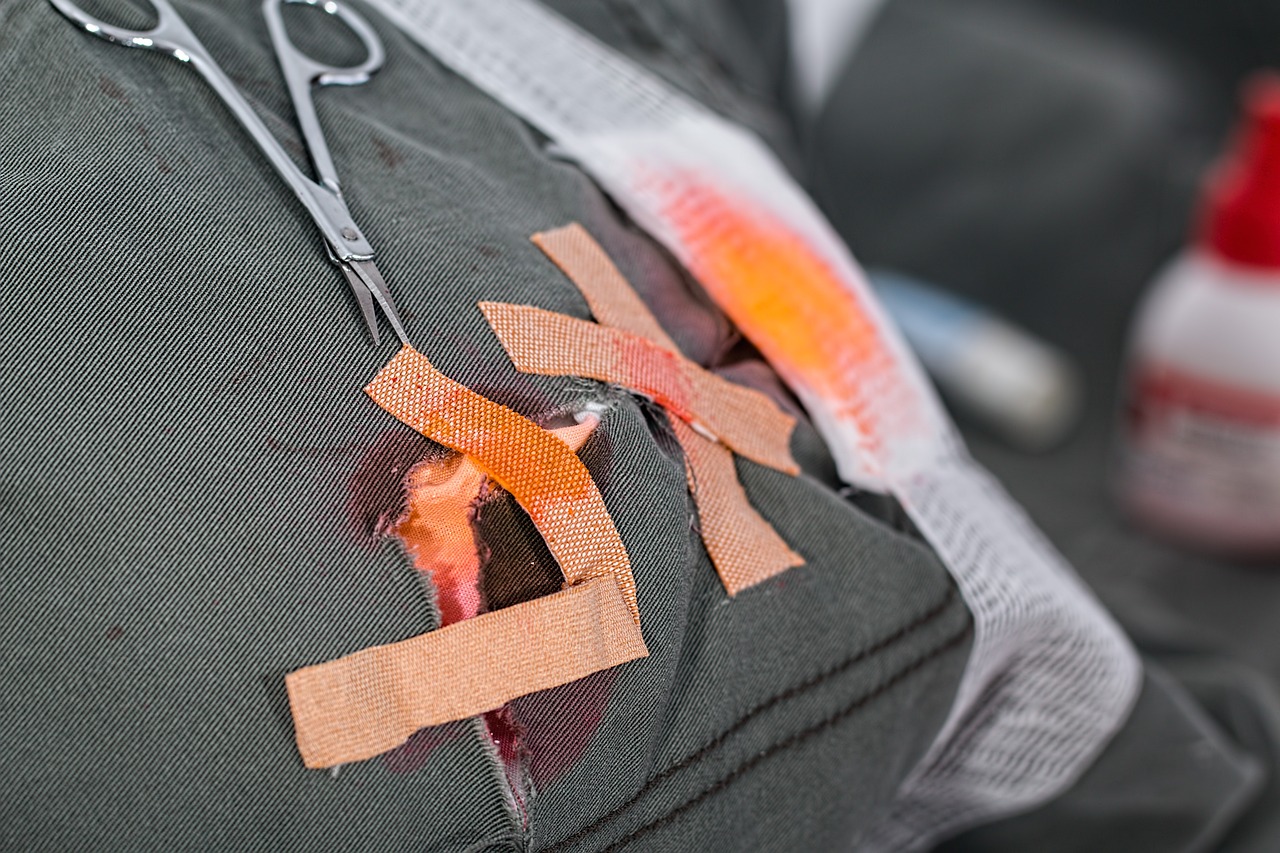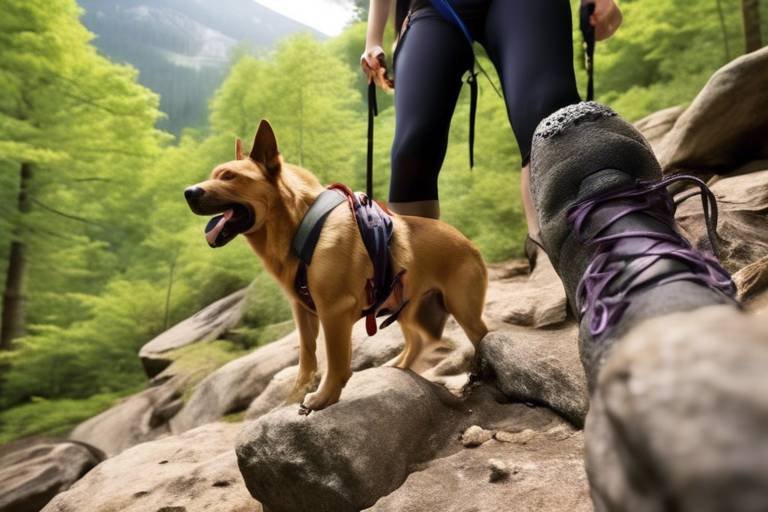What to Do If Your Pet Is Injured While Hiking
Hiking with your furry friend can be one of the most exhilarating experiences, but it also comes with its own set of risks. Imagine this: you're out in the great outdoors, surrounded by nature's beauty, when suddenly your beloved pet gets injured. Panic sets in, and you might feel overwhelmed. But don't worry! Knowing how to respond effectively can make all the difference. In this article, we’ll guide you through essential steps to take when your pet sustains an injury while hiking, ensuring that both you and your pet can navigate these challenges with confidence.
First and foremost, it’s vital to stay calm. Your pet can sense your anxiety, and panicking may only exacerbate the situation. Take a deep breath and assess the injury. Is it a minor scrape or something more serious? Understanding the nature of the injury will help you decide on the best course of action. Remember, your pet relies on you, so being composed is essential.
When you're out on the trail, it's crucial to be prepared. A well-stocked pet first aid kit can be a lifesaver. This kit should include items like antiseptic wipes, gauze, a digital thermometer, and even a pet-friendly pain reliever. Familiarizing yourself with these supplies before hitting the trail will equip you to handle minor injuries effectively. You wouldn’t hike without your gear, so why would you venture out without a first aid kit for your pet?
In the unfortunate event of an injury, the first step is to identify the type of injury your pet has sustained. Common injuries include cuts, sprains, and even heatstroke. For instance, if your pet has a cut, it’s important to clean the wound gently with saline solution and cover it with a sterile bandage. If you notice signs of heatstroke, such as excessive panting or lethargy, it’s crucial to cool your pet down immediately by providing water and finding shade.
Bandaging is another critical skill every pet owner should master. Proper bandaging can prevent further injury and protect wounds from dirt and bacteria. When applying a bandage, make sure it’s snug but not too tight, as this could impede circulation. You can use a roll of gauze and some adhesive tape to secure the bandage in place. If necessary, add a splint to stabilize a sprained leg, ensuring your pet is comfortable until you can seek veterinary assistance.
Another important consideration is the use of a muzzle. If your pet is in pain, they may react unpredictably. A muzzle can be a helpful tool to ensure safety during treatment. Just remember, it’s essential to use a muzzle only when necessary and to ensure your pet is comfortable with it. Practice using the muzzle at home so that your pet associates it with safety rather than fear.
Now, if your pet is bleeding severely, immediate action is required. Apply pressure directly to the wound using a clean cloth or gauze. If the bleeding doesn’t stop, elevate the injury above the heart level, if possible. These techniques can significantly minimize blood loss and buy you time to get your pet to a veterinarian.
Knowing when to seek veterinary care is just as important as providing first aid. If your pet shows signs of serious distress, such as difficulty breathing, unresponsiveness, or if the injury appears life-threatening, don’t hesitate to take them to the vet. Trust your instincts; you know your pet best.
Ultimately, prevention is key to ensuring a safe hiking experience for you and your furry friend. Before heading out, make sure your pet is in good physical condition and well-trained for the adventure ahead. Choosing the right gear, such as a sturdy harness and protective booties, can also significantly reduce the risk of injuries. Additionally, conditioning your pet through regular exercise will help them build strength and stamina, making them less susceptible to injuries on the trail.
In conclusion, being prepared and knowing how to respond to your pet’s injuries can transform a potentially distressing situation into a manageable one. So, the next time you lace up your hiking boots, remember these tips and enjoy the adventure with your furry companion!
- What should I include in my pet's first aid kit? A basic kit should contain antiseptic wipes, gauze, adhesive tape, a digital thermometer, and pet-safe pain relievers.
- How can I tell if my pet has heatstroke? Look for excessive panting, drooling, lethargy, and a rapid heartbeat. If you suspect heatstroke, cool your pet immediately.
- Is it safe to use a muzzle on my pet? Yes, but only if your pet is in pain and may react unpredictably. Ensure they are comfortable with the muzzle before using it.
- When should I take my pet to the vet? Seek veterinary care for serious symptoms like difficulty breathing, severe bleeding, or if your pet is unresponsive.

Recognizing Common Injuries
When you're out hiking with your furry companion, the last thing you want is for them to get hurt. However, accidents can happen, and being aware of common injuries is essential for any pet owner. Understanding these injuries and their symptoms can help you respond quickly and effectively. Some of the most frequent injuries your pet might encounter include cuts, sprains, and heatstroke, among others.
Cuts and Scrapes are perhaps the most common injuries, especially if your pet is exploring rocky terrains or thorny bushes. These can range from minor abrasions to deep lacerations that may require stitches. Watch for signs like excessive licking, swelling, or bleeding. If you notice any of these symptoms, it's time to take action.
Another injury to be aware of is sprains. Just like humans, pets can twist or overstretch their limbs, leading to painful sprains. If your pet is limping or favoring one leg, it could be a sign of a sprain. Pay attention to their behavior; if they seem reluctant to put weight on a limb, it’s crucial to assess the situation promptly.
Heatstroke is a serious condition that can occur during hot weather, especially if your pet is exerting themselves on a hike. Symptoms include excessive panting, drooling, lethargy, and even vomiting. If your pet shows any signs of heatstroke, you must act quickly to cool them down. Remember, prevention is key, so ensure you take plenty of breaks in shaded areas and keep your pet hydrated.
Other injuries may include insect bites or stings, which can lead to allergic reactions in some pets. If you notice swelling, redness, or your pet scratching excessively, they may have been bitten or stung. It's always wise to keep an eye out for any unusual behavior or physical changes in your pet while on the trail.
In conclusion, being able to recognize these common injuries can make a world of difference in your pet's safety during hikes. Always stay alert, and don't hesitate to check your pet for any signs of injury. Remember, a little awareness goes a long way in ensuring your outdoor adventures are enjoyable for both you and your furry friend!

First Aid Essentials for Pets
When you're out on the trails with your furry companion, the last thing you want is for them to get injured. However, accidents happen, and being prepared can make all the difference. Having a well-stocked pet first aid kit is essential for any pet owner who loves to hike. This kit should be tailored to your pet's specific needs, but there are some universal items that every first aid kit should include. Let's dive into the must-have essentials that can help you provide immediate care for your pet in case of an injury.
First and foremost, your kit should contain bandages of various sizes. These are crucial for covering cuts and scrapes to prevent infection. Additionally, having sterile gauze pads and adhesive tape will allow you to create a secure dressing. It's also wise to include some antiseptic wipes or a saline solution to clean wounds before bandaging them. Remember, a clean wound is less likely to get infected!
Next, consider adding some pet-safe pain relief medication to your kit. Just like us, pets can experience pain and discomfort, and having something on hand can help ease their suffering until you can get them to a vet. However, always consult your veterinarian for recommendations on what medications are safe for your specific pet.
Another important item is a pair of scissors. These can be used to cut bandages, clothing, or even to trim fur away from a wound. Just make sure they are blunt-tipped to avoid accidentally injuring your pet while using them. You should also have a thermometer to check your pet's temperature, as fevers can indicate more serious issues.
Don't forget about tweezers! These can be invaluable for removing splinters, ticks, or other foreign objects that might get stuck in your pet's skin. To keep your pet calm during treatment, consider including a muzzle in your kit. Even the sweetest of pets can react unpredictably when they're in pain, so having a muzzle can protect you from bites while you tend to their injuries. Just remember to use it responsibly and ensure it doesn't restrict their breathing.
To give you a clearer picture, here’s a quick overview of the essential items to include in your pet first aid kit:
| Item | Purpose |
|---|---|
| Bandages | To cover cuts and scrapes |
| Sterile Gauze Pads | For wound dressing |
| Antiseptic Wipes | To clean wounds |
| Pain Relief Medication | To alleviate pain |
| Scissors | To cut bandages or clothing |
| Thermometer | To check for fever |
| Tweezers | To remove splinters or ticks |
| Muzzle | To prevent bites during treatment |
Lastly, don't forget to include a copy of your pet's medical records and any specific medications they may need. This can be incredibly helpful if you need to seek veterinary care while out in the wilderness. Having a well-prepared first aid kit not only gives you peace of mind but also ensures that you can respond quickly and effectively if your pet gets injured. Remember, the best way to handle an emergency is to be prepared ahead of time!
- What should I do if my pet gets a cut while hiking? Clean the wound with antiseptic wipes, apply a sterile bandage, and monitor for signs of infection.
- How do I know if my pet needs to see a vet? If the injury is deep, bleeding heavily, or if your pet shows signs of distress, seek veterinary care immediately.
- Can I use human medication on my pet? No, always consult your veterinarian before giving your pet any medication meant for humans.
Bandaging Techniques
When your beloved pet gets injured while hiking, knowing how to properly bandage the wound can be a game-changer. It’s not just about wrapping a piece of cloth around the injury; it’s about securing the wound to prevent further damage and ensuring your furry friend is as comfortable as possible. So, let’s dive into some effective bandaging techniques that can help you manage your pet’s injury until you can get to a vet.
First and foremost, it’s essential to clean the wound before applying any bandage. Use clean water or saline solution to rinse away dirt and debris. This step is crucial because any foreign particles can lead to infection. Once the wound is clean, gently pat it dry with a clean cloth or gauze.
Next, you’ll want to apply a sterile dressing. You can use a non-stick pad or a piece of clean cloth. Place it directly over the wound, ensuring it covers the entire area. To keep the dressing in place, use a self-adhesive bandage or medical tape. Make sure it’s snug but not too tight, as you don't want to cut off circulation. A good rule of thumb is to check if you can slip a finger under the bandage; if you can, it’s likely just right.
For more serious injuries, like sprains or fractures, you may need to create a splint to immobilize the affected area. This can be done using a rigid material such as a stick or a rolled-up magazine. Position the splint alongside the injury and secure it with bandages or tape, ensuring it doesn’t move around. Remember, the goal is to keep the injured area stable until you can seek professional help.
Here’s a quick overview of the key steps in bandaging:
- Clean the wound with water or saline.
- Apply a sterile dressing over the injury.
- Secure the dressing with self-adhesive bandage or tape.
- For serious injuries, create a splint to immobilize the area.
It’s also important to monitor your pet after applying the bandage. Look for signs of discomfort or irritation, such as excessive licking or chewing at the bandage. If you notice any swelling or if the bandage becomes wet or dirty, it’s time to change it. Keeping the bandage clean and dry is vital for proper healing.
Lastly, always remember that while bandaging can provide immediate relief, it’s not a substitute for professional veterinary care. If your pet’s injury seems severe or if they exhibit symptoms like persistent pain, difficulty walking, or excessive bleeding, seek veterinary assistance as soon as possible. The sooner you act, the better the outcome for your furry companion.
Q: How do I know if my pet needs a bandage?
A: If your pet has a visible wound, bleeding, or signs of pain, a bandage may be necessary to protect the injury and prevent further harm.
Q: Can I use human bandages on my pet?
A: While human bandages can be used in emergencies, it's best to use pet-specific first aid supplies when available, as they are designed for animal anatomy.
Q: What materials should I avoid when bandaging my pet?
A: Avoid using materials that can stick to the wound, such as cotton balls or regular adhesive tape, as they can cause further injury when removed.
Q: How often should I change the bandage?
A: Change the bandage at least once a day or sooner if it becomes wet or dirty. Always check for signs of infection.
Using Muzzle for Safety
When you're out in the wild, enjoying the beauty of nature with your furry friend, the last thing you want is for them to get injured. However, if that unfortunate event occurs, it’s vital to have a plan in place to keep both you and your pet safe. One of the essential tools in your first aid kit is a muzzle. Now, you might be thinking, "Why would I need a muzzle for my pet if they’re hurt?" Well, it’s simple: injured animals can react unpredictably due to pain and fear. Just like how a cornered animal might lash out, your beloved pet might also bite in response to discomfort. Thus, using a muzzle can be a game-changer in these tense situations.
Before you head out on your hike, it’s crucial to ensure that your pet is comfortable with wearing a muzzle. This is where training comes into play. Introduce the muzzle gradually at home, allowing your pet to sniff it and even reward them with treats for wearing it. This positive reinforcement helps them associate the muzzle with good experiences. When the time comes to use it, they’ll be more likely to tolerate it. Remember, a muzzle should never be used as a punishment; it should be a safety measure that promotes calmness during stressful situations.
There are various types of muzzles available, and choosing the right one can make all the difference. Here are a few options:
- Basket Muzzles: These allow your pet to breathe, drink, and even bark while preventing biting. They are ideal for longer durations.
- Soft Muzzles: Great for short-term use, these are typically made from fabric and can be more comfortable for your pet.
- Cage Muzzles: These are sturdy and provide maximum ventilation and comfort but are often less comfortable for long-term wear.
When applying the muzzle, ensure it fits snugly but not too tight. You should be able to fit two fingers between the muzzle and your pet’s snout. This will allow your pet to breathe comfortably while still keeping them safe. If your pet is small, you can even carry a muzzle in your backpack, just in case you need it.
In summary, using a muzzle can be a critical part of your first aid strategy while hiking with your pet. It’s not just about preventing bites; it’s about creating a safe environment where you can administer care without fear. Just like a lifeguard carries a flotation device, having a muzzle on hand can be a lifesaver in emergencies. So, take the time to train your pet, choose the right muzzle, and always be prepared. Your pet’s safety is worth it!
Q: Is it necessary to use a muzzle on my pet during hikes?
A: While not always necessary, a muzzle can be a valuable tool in case of injury, as it helps prevent bites when a pet is in pain.
Q: How do I choose the right muzzle for my pet?
A: Consider your pet's size and comfort. Basket muzzles are often recommended for longer wear, while soft muzzles are suitable for short-term use.
Q: Can I use a muzzle on a dog that has never worn one before?
A: Yes, but it's essential to train your dog to wear the muzzle before you need it. Gradual introduction and positive reinforcement can help.
Q: How long can my pet wear a muzzle?
A: It depends on the type of muzzle. Basket muzzles can be worn for longer periods, while soft muzzles should be used for short durations only.
Managing Bleeding
When your furry friend gets injured while hiking, one of the most alarming situations you might face is severe bleeding. It's crucial to act quickly and calmly. First, assess the injury to determine the severity of the bleeding. Is it a small cut, or is it a deep wound? The way you manage the bleeding can make a significant difference in your pet's outcome. Here’s a step-by-step guide to help you control bleeding effectively.
To start, you want to ensure both you and your pet are in a safe environment. If your pet is in pain, they might react unpredictably. Always remember to stay calm; your pet can sense your anxiety. If possible, gently restrain your pet to prevent sudden movements that could worsen the injury. If you have a muzzle, consider using it to protect yourself from bites, but only if your pet is comfortable with it.
Now, let’s talk about how to manage the bleeding:
- Apply Direct Pressure: Use a clean cloth or bandage and press it firmly against the wound. This direct pressure helps to stop the bleeding by allowing the blood to clot.
- Elevate the Injury: If the injury is on a limb, try to elevate it above the level of the heart. This can help reduce blood flow to the area and minimize blood loss.
- Use a Tourniquet (if necessary): In extreme cases where bleeding is life-threatening and does not stop with direct pressure, a tourniquet may be necessary. However, this should be a last resort, as it can cause tissue damage if left on for too long.
After applying pressure for a few minutes, check to see if the bleeding has stopped. If it hasn’t, continue applying pressure and consider wrapping the wound with a bandage to keep it secure. Remember, if the bleeding is profuse or does not stop after 10 minutes, it’s time to seek veterinary care immediately. Your vet will have the tools and expertise needed to handle severe injuries.
Lastly, keep an eye on your pet for signs of shock, which can include rapid breathing, weakness, or a pale tongue and gums. If you notice these symptoms, it’s vital to get your pet to a vet as soon as possible, even if you’ve managed the bleeding. Remember, your quick actions can make a world of difference in your pet’s recovery.
Q: What should I include in a pet first aid kit?
A: Your kit should include items like bandages, antiseptic wipes, gauze, tweezers, and a muzzle. Don’t forget to add a pet-specific first aid manual!
Q: How can I tell if the bleeding is serious?
A: If the bleeding is profuse, doesn’t stop after applying pressure, or if your pet shows signs of shock, it’s serious and requires immediate veterinary attention.
Q: Can I use human first aid supplies on my pet?
A: Yes, but be cautious. Some human products, like certain antiseptics, can be harmful to pets. Always check with your vet.
When to Seek Veterinary Care
Recognizing when to take your furry friend to the vet can be a game-changer during your hiking adventures. It's not just about the visible injuries; sometimes, the most serious issues are lurking beneath the surface, waiting to rear their ugly heads. As a responsible pet owner, you need to be vigilant and aware of the signs that indicate your pet requires professional medical attention. But what exactly should you be looking for?
First and foremost, if your pet has sustained an injury that results in excessive bleeding, you should seek veterinary care immediately. Severe bleeding can be life-threatening, and every second counts. Apply pressure to the wound and elevate the injured area while you make your way to the vet. Additionally, if your pet is showing signs of distress, such as whining, excessive panting, or difficulty walking, it's time to consult a professional. These behaviors can indicate pain that may not be immediately obvious.
Another critical factor to consider is changes in behavior. If your normally playful pup suddenly becomes lethargic or refuses to eat or drink, don’t brush it off as just a bad day. These could be signs of internal injuries or infections that need to be addressed. Keep an eye out for symptoms such as:
- Persistent vomiting or diarrhea
- Swelling in any part of the body
- Difficulty breathing or coughing
- Unusual aggression or fearfulness
Additionally, if your pet has been exposed to extreme heat during your hike and exhibits symptoms like excessive panting, drooling, or disorientation, it could be a sign of heatstroke. This is a medical emergency and requires immediate veterinary care. Remember, pets can’t sweat like us, and they can overheat quickly, especially during strenuous activities.
Sometimes, the injuries can be less obvious but still serious. For example, if your dog has a sprained leg, it may not be able to put weight on it. If you notice your pet limping or favoring a particular leg, don’t hesitate to take them in for an evaluation. Early detection can make a significant difference in treatment outcomes.
In conclusion, being proactive about your pet’s health during and after hikes is crucial. Knowing the signs that necessitate a trip to the vet can save your pet from unnecessary suffering and ensure they return to their playful selves as quickly as possible. Always err on the side of caution—if in doubt, it’s better to consult your veterinarian for peace of mind.
Q: What should I do if my pet gets injured on the trail?
A: Assess the injury, apply basic first aid, and determine if veterinary care is needed based on the severity of the injury.
Q: How can I tell if my pet is in pain?
A: Look for signs such as whining, limping, excessive panting, or changes in behavior. If you notice any of these symptoms, consult a vet.
Q: What are the signs of heatstroke in pets?
A: Symptoms include excessive panting, drooling, lethargy, vomiting, and disorientation. If you suspect heatstroke, seek veterinary help immediately.
Q: Is it necessary to carry a first aid kit for my pet while hiking?
A: Yes! A pet first aid kit can be invaluable for treating minor injuries and stabilizing your pet until you can reach a vet.

Preventing Injuries in the Future
When it comes to hiking with your furry friend, prevention truly is the best medicine. Just like we wouldn’t hit the trails without proper gear and preparation, our pets deserve the same level of care. Imagine setting off on a grand adventure, but instead of facing the thrill of the wild, your pet ends up hurt and in distress. To avoid such heart-wrenching scenarios, there are several proactive steps you can take.
First and foremost, choosing the right gear for your pet is essential. Think of it as equipping them with their very own hiking armor. Just as you wouldn’t wear flip-flops on a rocky trail, your pet needs footwear that protects their paws from sharp stones and hot surfaces. Consider investing in booties that provide traction and protection. Additionally, a sturdy harness can prevent injuries caused by sudden pulls or slips, giving you better control over your pet during your hike.
But gear alone isn’t enough. You must also focus on training and conditioning. A well-conditioned pet is less likely to suffer from fatigue or injuries. Just like athletes train for endurance, your pet can benefit from gradual increases in activity levels. Start with shorter hikes and progressively extend the distance. This way, your pet builds strength and stamina, making them more resilient against the rigors of the trail. Incorporate various terrains during training to prepare them for the unexpected.
Moreover, mental preparation is just as crucial as physical readiness. Dogs, especially, thrive on routine and familiarity. Before heading out, take a moment to familiarize your pet with the trail. Walk them on a leash, allowing them to sniff around and explore the environment. This not only calms their nerves but also helps them understand what to expect. After all, a relaxed pet is less likely to dart off or panic, which can lead to accidents.
Lastly, don’t forget to keep an eye on the weather. Extreme temperatures can pose serious risks. On hot days, ensure your pet stays hydrated and take frequent breaks in the shade. On the flip side, cold weather can lead to frostbite or hypothermia. Always check the forecast and adjust your plans accordingly. Being prepared means being aware of the elements that could impact your pet’s safety.
In summary, preventing injuries during hikes is all about preparation, proper gear, and gradual training. By taking these steps, you can enjoy your outdoor adventures with peace of mind, knowing that your furry companion is well-equipped for whatever nature throws your way.
- What should I include in my pet's first aid kit?
Essential items include antiseptic wipes, bandages, gauze, scissors, and any specific medications your pet may need. - How can I tell if my pet is in pain?
Signs of pain in pets can include whimpering, limping, excessive licking of a specific area, or changes in behavior. - Is it safe to hike with my pet in hot weather?
While it can be safe, always ensure your pet has access to water, take breaks, and watch for signs of overheating. - What should I do if my pet gets lost while hiking?
Stay calm, call their name, and retrace your steps. If they don’t return, consider bringing a whistle or a GPS tracker for future hikes.
Choosing the Right Gear
When it comes to hiking with your furry friend, the right gear can make all the difference between a fun adventure and a potential disaster. Just like we wouldn’t set off on a trek without our trusty backpack filled with essentials, our pets need their own gear to ensure they stay safe and comfortable. So, what should you be looking for? Let’s break it down.
First and foremost, a good harness is essential. Unlike collars, which can put pressure on a pet's neck, a harness distributes the force across their body. This is particularly important if your pet is prone to pulling or if you need to help them over tricky terrain. Look for a harness that fits snugly but comfortably, allowing for movement without chafing. Some harnesses even come with a handle on the back, which can be a lifesaver when you need to lift your pet over obstacles or help them navigate steep climbs.
Next up, consider booties. Yes, those adorable little shoes for your dog! While they may look cute, they serve a practical purpose. Hiking trails can be rough, with sharp rocks, hot pavement, or icy patches, all of which can hurt your pet’s paws. Booties protect their feet from injury and provide better traction on slippery surfaces. It might take some time for them to get used to wearing them, but trust me, they’ll thank you when they’re not limping back home!
Another crucial piece of gear is reflective gear. If you’re hiking in low-light conditions or planning to stay out until dusk, reflective vests or collars can help keep your pet visible. It’s not just for their safety; it also gives you peace of mind knowing that your furry companion is easily seen by others. Plus, it can be a great conversation starter with fellow hikers!
Lastly, don’t forget about hydration. Just like you need water to stay energized on your hike, your pet does too. A portable water bowl or a hydration pack designed for pets can make it easy to keep them hydrated throughout your adventure. Always make sure to take breaks and offer them water, especially on hot days.
In summary, choosing the right gear for your pet can significantly enhance your hiking experience. Investing in a quality harness, booties, reflective gear, and hydration solutions not only protects your pet but also allows you to enjoy your time outdoors without worry. Remember, a well-equipped pet is a happy pet, and a happy pet makes for a happier hike!
- What type of harness is best for hiking? A padded, adjustable harness that distributes pressure evenly is ideal. Look for one with a handle for added control.
- Do all dogs need booties? Not all dogs require booties, but they are beneficial for those with sensitive paws or when hiking on rough terrain.
- How can I ensure my pet stays hydrated while hiking? Bring a portable water bowl or hydration pack, and make sure to take regular breaks to offer them water.
- What should I do if my pet refuses to wear booties? Introduce them gradually at home, allowing them to get used to the feel before hitting the trails.
Training and Conditioning
When it comes to hiking with your furry friend, are absolutely essential. Just like us, pets need to build their strength and endurance to tackle those rugged trails. Imagine trying to run a marathon without any training—your pet feels the same way on a long hike! So, how do we prepare our beloved companions for the great outdoors? Let's dive into some effective strategies.
First and foremost, start with basic obedience training. It’s crucial for your pet to respond to commands like "sit," "stay," and "come." This not only keeps them safe but also helps you manage their behavior in unfamiliar environments. You wouldn’t want your dog darting after a squirrel into the woods, right? A well-behaved pet is a happy pet, and it makes the hiking experience enjoyable for both of you.
Next up is conditioning your pet physically. Gradually increase the intensity and duration of your walks. Begin with short, easy hikes and progressively introduce more challenging terrains. This gradual buildup allows your pet's muscles and joints to adapt to the demands of hiking. You can follow a simple schedule:
| Week | Activity | Duration |
|---|---|---|
| 1 | Short Walks | 20-30 minutes |
| 2 | Easy Trails | 30-45 minutes |
| 3 | Moderate Trails | 45-60 minutes |
| 4 | Challenging Trails | 1-2 hours |
This table serves as a guideline to help you progressively train your pet. Remember, every pet is unique, so adjust the duration and intensity according to your pet’s needs and fitness level. Just like a personal trainer would advise, listen to your pet’s body language—if they seem tired or reluctant, it’s time to dial it back a bit.
Incorporating mental stimulation is also key. Hiking can be physically demanding, but it can also be mentally taxing for your pet. Engage their mind with fun activities like scent games or obedience drills during breaks. This not only keeps their energy levels balanced but also strengthens your bond. Think of it as a workout for their brain—after all, a tired brain can lead to a well-behaved pet!
Lastly, don’t forget about hydration and nutrition. Always carry enough water for both you and your pet, and consider their dietary needs. A high-energy trail mix designed for dogs can be a great snack during your hikes, providing them with the energy boost they need. Just like you wouldn’t hike on an empty stomach, neither should your pet!
In summary, training and conditioning your pet for hiking is a combination of physical preparation, obedience training, mental challenges, and proper nutrition. With the right approach, you can ensure that your pet is not just ready for the trail but excited to embark on new adventures with you!
- How long should I train my pet before hiking? Start training at least a few weeks in advance, gradually increasing the difficulty of your walks.
- What commands should I teach my pet before hiking? Focus on basic commands like "sit," "stay," and "come" to ensure safety on the trail.
- How can I keep my pet hydrated while hiking? Always carry sufficient water for both you and your pet, and take breaks to hydrate regularly.
- What should I do if my pet gets tired on the hike? Listen to your pet's cues; if they seem tired, take a break or cut the hike short.
Frequently Asked Questions
- What should I do if my pet gets injured while hiking?
If your pet gets injured while hiking, the first step is to assess the injury. If it’s minor, you can treat it with your first aid kit. For more serious injuries, keep your pet calm and apply pressure to any bleeding wounds. Always seek veterinary care if you're unsure about the severity of the injury.
- How can I recognize if my pet is injured?
Look for signs such as limping, whining, excessive licking of a specific area, or visible wounds. If your pet seems unusually quiet or refuses to move, these could be signs of injury. Always trust your instincts; if something seems off, it’s best to consult a vet.
- What items should I include in a pet first aid kit?
Your pet first aid kit should include items like adhesive bandages, gauze, antiseptic wipes, tweezers for splinter removal, a muzzle for safety, and a thermometer. Consider adding any medications your vet recommends for your pet’s specific needs.
- When is it necessary to take my pet to the vet?
If your pet shows signs of severe bleeding, difficulty breathing, or if they lose consciousness, you should seek veterinary care immediately. Additionally, if the injury seems serious or if your pet is in significant pain, don’t hesitate to contact your vet.
- How can I prevent injuries while hiking with my pet?
To minimize the risk of injuries, ensure your pet is physically fit and well-trained for hikes. Use appropriate gear, such as harnesses and booties, and always keep an eye on your pet for signs of fatigue or discomfort. Gradually increase the difficulty of your hikes to build their stamina.
- Is it safe to use a muzzle on my pet if they are injured?
Yes, using a muzzle can be safe and necessary if your pet is in pain and may react unpredictably. Ensure the muzzle is properly fitted and only use it when needed, such as during treatment or transport to a vet.
- What should I do if my pet shows signs of heatstroke?
If you suspect your pet has heatstroke, move them to a cool area immediately and offer water. You can also wet their fur with cool (not cold) water. Contact your vet right away, as heatstroke can be life-threatening if not treated quickly.



















